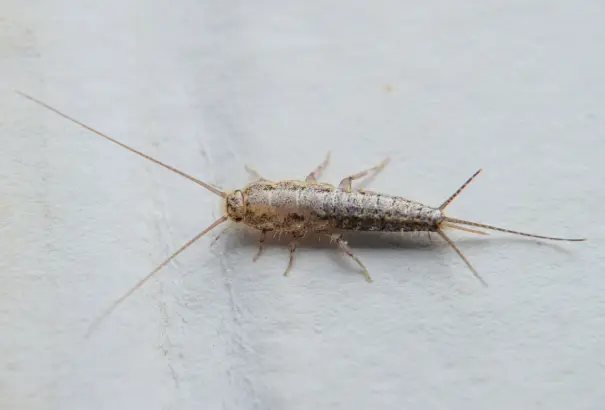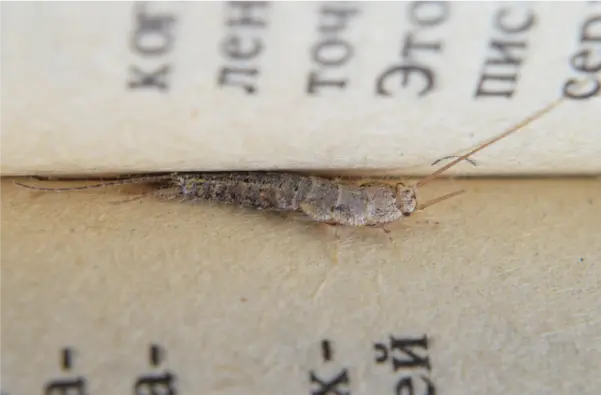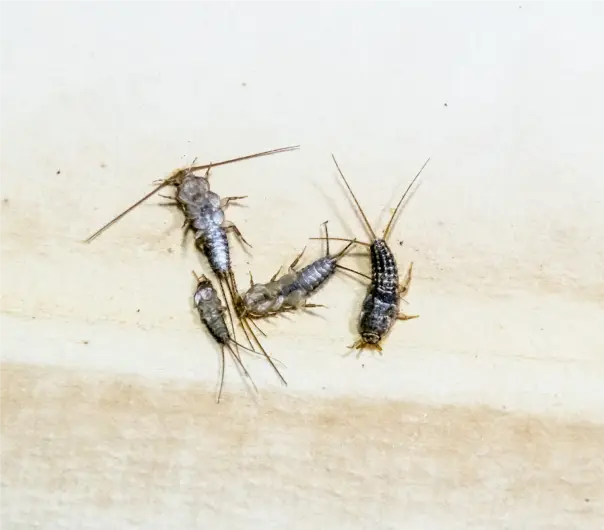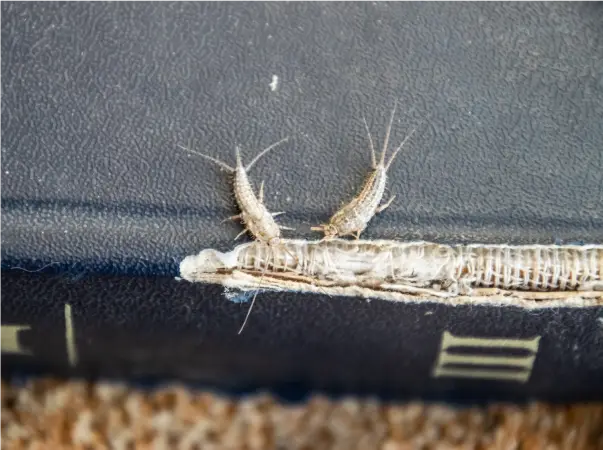Silverfish: The Shimmering Sneaky Thieves of Your Home!
Ever spotted a silvery, wriggling bug darting across your bathroom floor or hiding in a bookcase? That would be a silverfish—a fast-moving, moisture-loving pest that thrives in dark, damp spaces. While they don’t bite or spread disease, they love to snack on paper, fabric, and even starchy foods, making them a pesky intruder in homes and businesses.
These ancient insects have been around for over 400 million years, meaning they’ve mastered the art of survival and sneaky hiding spots. If you are noticing chewed-up books, damaged wallpaper, or creepy little critters zipping across your floors, it’s time to kick these shimmering invaders out for good! Give our amazing team a call today!
Silverfish Control & Prevention
 Silverfish may not bite or spread disease, but they can still be a major nuisance in homes and businesses. These fast-moving, nocturnal pests love dark, damp spaces and feed on paper, fabrics, adhesives, and even pantry items. If you have noticed damaged books, holes in clothing, or silvery insects scurrying away when you turn on the lights, a silverfish infestation could be lurking in your home.
Silverfish may not bite or spread disease, but they can still be a major nuisance in homes and businesses. These fast-moving, nocturnal pests love dark, damp spaces and feed on paper, fabrics, adhesives, and even pantry items. If you have noticed damaged books, holes in clothing, or silvery insects scurrying away when you turn on the lights, a silverfish infestation could be lurking in your home.
Our silverfish control services target both active infestations and the conditions that attract these pests, ensuring your home stays silverfish-free for the long term.
Comprehensive Site Inspection
- Identify silverfish activity in high-risk areas such as bathrooms, basements, kitchens, and storage spaces
- Locate potential food sources, including books, paper products, clothing, and dry food storage
- Assess environmental factors contributing to silverfish infestations, such as high humidity, moisture leaks, and cluttered storage areas
- By understanding the extent of the infestation and conducive conditions, we develop a tailored treatment plan for effective control
Effective Silverfish Control Measures
After assessing your home, we implement strategic pest control measures to eliminate silverfish and prevent reinfestation.
Targeted Silverfish Treatments
- Residual insecticide applications in key hiding spots, including baseboards, closets, attics, and storage areas
- Baiting strategies in areas with high silverfish activity to reduce populations
- Crack and crevice treatments to reach silverfish hiding in walls, flooring gaps, and behind appliances
Moisture & Environmental Control
- Identifying and addressing moisture issues (leaky pipes, high humidity, poor ventilation)
- Recommending dehumidifiers or improved airflow solutions in damp areas
- Encouraging better storage practices—reducing clutter, sealing food, and keeping books and documents in dry conditions
Ongoing Prevention & Monitoring
- Silverfish thrive in environments with high moisture and ample hiding spaces. Our recurring pest control services help reduce silverfish populations and prevent reinfestation.
Professional Silverfish Control Services
While silverfish do not bite or transmit diseases, they can still be a major nuisance, causing damage to books, clothing, wallpaper, and dry food products. Their rapid reproduction and preference for dark, humid spaces make them particularly difficult to eliminate without a targeted approach.
Our silverfish control services focus on eliminating existing infestations while addressing the conditions that attract them. Since silverfish can survive for long periods without food, a comprehensive plan is necessary to reduce their numbers and prevent reinfestation.
- We target silverfish at all life stages, ensuring long-term control
- Moisture and habitat reduction play a key role in silverfish prevention
- Our treatments are designed to eliminate active infestations while discouraging future activity
If silverfish have taken up residence in your home or business, do not wait for the damage to add up—contact us today for expert silverfish control!
- Quarterly & Bi-Monthly Programs
- Target Pests: Ants, spiders and various other crawling insects
-
Service Includes:
- Exterior perimeter inspection and application for crawling insect control
- Removal of accessible wasp nests on the structure of your home
- Sweeping of spider webs followed by an overhead application for spider control
- Interior services as needed
- Quarterly & Bi-Monthly Programs
- Target Pests: Rats, mice, ants, spiders and various other crawling insects.
-
Service Includes:
- Exterior perimeter inspection and application for crawling insect control
- Removal of accessible wasp nests on the structure of your home
- Sweeping of spider webs followed by an overhead application for spider control
- Service exterior rodent bait stations and inspect for potential entry points
- Interior services as needed
- Quarterly & Bi-Monthly Programs.
- Target Pests: Rats & Mice.
-
Service Includes:
- Exterior perimeter inspection for potential entry points, nesting areas or food sources.
- Seal up identified entry points to prevent the rodents from accesses the interior of your home.
- Service exterior and interior rodent bait stations.
- Interior services as needed.
Identification
How to Identify a Silverfish
Silverfish are unique-looking insects that are often mistaken for centipedes or firebrats. Their fast, darting movements and silvery, metallic appearance make them easy to recognize once you know what to look for.
 Key Characteristics of Silverfish
Key Characteristics of Silverfish
- Size: ½ to ¾ inch long, not including their antennae or tail filaments
- Color: Silvery-gray to metallic blue, giving them a shimmering appearance
- Shape: Tapered, teardrop-shaped bodies, wider at the head and narrowing toward the tail
- Antennae: Long, thread-like antennae, nearly as long as their bodies
- Tail Appendages: Three long, bristle-like filaments extending from the rear, resembling fish tails
- Movement: Fast and wriggling, similar to a fish, especially when disturbed
Where to Find Silverfish
Silverfish prefer dark, humid areas, and are most active at night. They often hide in:
- Bathrooms & Laundry Rooms – Found near sinks, tubs, and damp towels
- Basements & Crawl Spaces – Thrive in humid, poorly ventilated areas
- Kitchens & Pantries – Hide in cupboards, behind appliances, and in food storage areas
- Bookshelves & Storage Boxes – Infest old books, cardboard, and wallpaper glue
- Attics & Closets – Found in stored clothing, old papers, and insulation
 Signs of a Silverfish Infestation
Signs of a Silverfish Infestation
- Shed Skins & Droppings – Silverfish molt throughout their lives, leaving behind tiny transparent exoskeletons. Their droppings look like small black pepper-like specks.
- Paper & Fabric Damage – Small, irregular holes in books, wallpaper, clothing, or cardboard may indicate silverfish feeding
- Food Contamination – Silverfish invade dry food storage, such as cereal, flour, sugar, and pet food
- Sightings at Night – If you turn on a light and see silvery insects darting for cover, you likely have silverfish
How to Confirm Silverfish Are Present
- Place insect monitors or glue boards in areas where you have seen silverfish activity—near baseboards, in bathrooms, on book shelves, behind furniture, or in damp storage spaces. If you catch silverfish, you know they are actively infesting your home or business.
Get Rid of Silverfish—For Good!
Silverfish multiply quickly and can be difficult to control without professional help—contact us today for expert silverfish control solutions!
Risks
Are Silverfish Dangerous?
Silverfish pose no direct health risks but their presence can lead to property damage, contamination, and allergic reactions in some individuals. Here are a few risks or concerns associated with Silverfish:
Property Damage – Silverfish feed on starch-based materials, including:
- Books, important documents, and wallpaper (they consume glue and paper fibers)
- Stored clothing and fabrics, particularly those made of cotton, linen, or silk
- Cardboard storage boxes, damaging items kept in basements or attics
Food Contamination – Silverfish are known to invade pantries, feeding on:
- Dry goods like flour, oats, sugar, and pasta
- Pet food, cereal, and starch-based products
- Though they don’t transmit diseases, their presence in food storage can lead to contamination
Allergy & Asthma Concerns
- The shed scales and droppings of silverfish can trigger allergies and respiratory issues in sensitive individuals, similar to dust mites
Sign of Moisture Problems
- Silverfish thrive in damp, humid environments. Their presence may indicate underlying moisture issues, such as leaky pipes, poor ventilation, or water damage, which could lead to mold growth or structural problems if left unaddressed.
Silverfish Control Methods
Silverfish infestations require a multi-step approach, targeting both the existing population and the environmental factors that attract them. Because they thrive in dark, humid environments and can survive for months without food, completely eliminating them requires a combination of inspection, habitat modification, and targeted treatments.
 Identifying & Eliminating Silverfish Hotspots
Identifying & Eliminating Silverfish Hotspots
- Detailed Inspection – Silverfish are nocturnal and prefer to hide in dark, undisturbed areas. We inspect bathrooms, basements, attics, storage areas, bookshelves, and pantries to locate their hiding spots.
- Eliminating Food Sources – We help identify and remove starch-based materials they consume, such as paper products, cardboard, stored food, and fabric items.
- Targeting Moisture Issues – Since silverfish thrive in high-humidity environments, we recommend fixing leaks, improving ventilation, and using dehumidifiers in affected areas.
Challenges in Silverfish Control
- Resilient & Fast-Moving – Silverfish are quick runners, making them difficult to capture or kill with simple DIY methods.
- Hidden Infestations – These pests often remain out of sight, hiding behind baseboards, inside wallpaper seams, and within bookshelves.
- Slow but Steady Damage – Because silverfish consume paper, glue, clothing fibers, and even pantry items, they can cause long-term structural and material damage if left unchecked.
Finding Silverfish in Unexpected Places
- Silverfish infestations are often discovered in unexpected areas, such as:
- Old stacks of newspapers, magazines, and books stored in attics or basements
- Wallpaper seams, baseboards, and insulation, where they feed on glue and starch
- Stored clothing, blankets, or fabric items, especially in damp storage spaces
- Pantries and dry food storage, where they invade flour, cereal, oats, and pet food
Because silverfish can survive for months without food, infestations can persist unnoticed until damage becomes visible. Silverfish infestations can quickly spread throughout your home, damaging books, wallpaper, fabrics, and dry food. The longer they go untreated, the harder they are to remove but we are here to help so please give us a buzz!
Prevention Tips
Silverfish Prevention Tips
Silverfish thrive in dark, humid environments and can survive for months without food. The key to prevention is eliminating their food sources, reducing moisture, and sealing off hiding spots. Follow these simple but effective tips to keep silverfish out of your home or business!
 Reduce Moisture & Humidity
Reduce Moisture & Humidity
- Silverfish need high humidity to survive, so controlling moisture is the first step in prevention
- Use dehumidifiers in basements, attics, and crawl spaces
- Fix leaky pipes, faucets, and drains to prevent damp conditions
- Ensure proper ventilation in bathrooms, kitchens, and laundry rooms
- Keep basements & storage areas dry—avoid stacking cardboard boxes directly on floors
Eliminate Food Sources
- Silverfish feed on starchy materials like paper, fabric, and pantry items
- Store dry goods in airtight containers to prevent contamination
- Keep pet food sealed and stored off the floor
- Regularly vacuum and dust to remove food particles and potential egg sites
- Reduce clutter, especially stacks of newspapers, magazines, and cardboard
Protect Books, Documents, & Clothing
- Silverfish love old books, wallpaper glue, and natural fabrics
- Store important documents in plastic containers instead of cardboard boxes
- Rotate stored clothing and linens, especially in damp storage spaces
- Seal wallpaper edges properly to prevent silverfish from feeding on the glue
Seal Entry Points & Hiding Places
- Silverfish are sneaky and can hide in cracks, crevices, and wall voids
- Seal gaps around baseboards, pipes, and vents with caulk
- Install weather stripping on doors and windows to prevent entry
- Use storage bins instead of cardboard boxes in basements and attics
Regular Inspections & Maintenance
- Even with good prevention, silverfish can still find a way inside
- Inspect your home regularly for signs of silverfish activity, such as shed skins, small holes in paper products, or droppings
- Check behind furniture, in closets, and along baseboards for silverfish hiding spots
- Set up insect monitors or glue boards in high-risk areas as an early detection method

